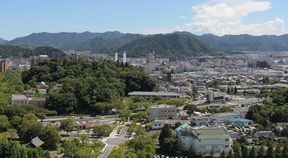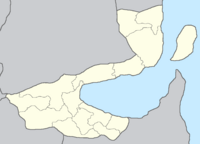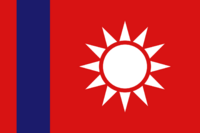Yilan
Yilan 宜兰市 Yílán shì | |
|---|---|
City | |
Clockwise from top: Yilan skyline, University of Yilan, Dazheng Temple | |
Map of Monsilva with Yilan highlighted | |
| Country | |
| State | |
| Settled | 9th century BCE |
| Declared city | 30 April 1735 |
| Nanyan state est. | 3 June 1983 |
| Government | |
| • Body | Yilan County Council |
| • Governor | Mo Qingshan (RNP) |
| Population (July 2022) | |
| • Total | 486,489 |
| Time zone | AMT+13 (Monsilvan Eastern Time, MET) |
| ISO 3166 code | MS-NAN-Y |
| Transit System(s) | MRA |
| Police[1] | Yilan County Police |
| Ambulance[2] | Nanyan State Ambulance |
| Fire[3] | Nanyan Fire Service |
Yilan (Monsilvan: 宜兰市; pinyin: Yílán shì), is a city in Monsilva and the capital of the state of Nanyan. The city is the smallest state capital, having slightly more than half of the population of the next smallest state capital, Taimali. Yilan is located in east Nanyan near the border with the state of Huachang. As the capital of Nanyan, Yilan is the seat of the Nanyan State Government, and is home to the Nanyan State Office. The city has an estimated population of 486,489 (June 2022). Yilan is Monsilva's 22nd most-populous city, which places it above Gumiao, but behind Yuzhen. Yilan holds 31% of the state of Nanyan's population, with the other 69% living in the cities of Lancheng, Duchang, Poyang or in other towns and villages located across the state.
Yilan is one of Monsilva's younger cities, having been formally declared after the Empire of Baltanla during the Kingdom of Great Shan, whilst most cities of Yilan's size and bigger were established during the Zhou dynasty. This also makes most of Yilan's population descending from people who did not originate from the original settlers during the Ji dynasty which existed around the 8th century BCE. Yilan is not considered a major tourist attraction, however, it does offer some sights such as the Dazheng Temple. Yilan is served by railways, highways and bus lines which allow travellers to enter and exit the city. The Monsilvan Railways Administration operates services from Yilan to other cities such as Dazhen and Amking.
Contents
Toponymy
The name Yilan comes directly from the HY Pinyin of the Monsilvan "宜蘭" (Yílán). The name has an unknown origin, however the meaning is thought to be related to the direct translation of the two characters "宜", meaning "proper" and "蘭", meaning "orchid".
History
Yilan has been inhabited for over 2000 years, however its population remained low due to its remoteness from the rest of the continent. It was absorbed into the Ji dynasty around 765 BCE where it remained until around 844 CE when the Yuan dynasty, a successor to the Ji dynasty, was invaded by the Sun dynasty. This war resulted in the Nanyan region being transferred to the dynasty including Yilan. During this period, Yilan's population grew slightly, turning it from a village into a town that was actually connected to the rest of the dynasty.
During the Zhou dynasty, which lasted from the beginning of the 13th century until the mid 16th century, Yilan's population began declining again due to neglect from the dynasty's central government. It remained this way, even into the Empire of Baltanla, where although the town received some money from travellers, it was mostly left to survive on its own. The population sat barely into the hundreds of people, until after indpendence during the Kingdom of Great Shan, when the city began to receive an influx of people moving east from the regions of Xishanjia and Wuzhong. They quickly outnumbered the native population of Yilan, and this is still evident today with Yilan having a higher proportionality of followers of Buddhism than other cities in eastern Monsilva.
In 1978, the state of Nanyan was established succeeding the prefecture of Nanyan. Later, in 1983, the Nanyan State Government was founded, and Yilan was chosen as its home, making it the capital of Nanyan.
Government
Yilan has its own county council, which administers the entire county of Yilan. The county consists of the city and its surrounding area. The county council is currently lead by the Reformed National Party
As Yilan is the capital of Nanyan, it is home to the Nanyan State Government in the State Office. The Nanyan State Parliament, also in the State Office, is a 34-seat unicameral legislature which serves the entire state of Nanyan, including Yilan. The seats correspond to each municipality of the state, some of which are Yilan's urban municipalities.
Geography
Yilan is located in the southern part of what is mostly known as the Eastern Huachang Plains. However, in the south of the city, the terrain gets significantly more hilly. The city is very warm, and is the hottest state capital and one of the hottest cities in Monsilva alongside Lunbei.
Cityscape
Demography
As of 2022, there are over 485,000 people living within Yilan's metropolitan area which makes it Monsilva's eighteenth-largest city by population, and the least-populous state capital. The city is split in thirds between Buddhists, followers of the Monsilvan folk religion, and everything else (other religions and irreligious people).
Education
Yilan is home to many educational institutions including the University of Yilan, which focuses on educating people with learning difficulties or other conditions that make studying at a normal university more difficult. The university is not ranked alongside other universities, but it has received praise for its service to the disabled community. Education in Nanyan is mandatory up to the age of 16 aligning with both Nanyan State Law and Monsilvan Federal Law.
Culture
Yilan's original culture has been lost through time, with limited historical records on the far south of Monsilva throughout the majority of Monsilvan history. However, modern Yilan culture is noticeable and a thriving part of the city. The city's modern culture originates from western Monsilvans as opposed eastern despite its eastern location. This is due to a large portion of the city's population descending from Monsilvans and Baltanians who came from areas like Xishanjia and Wuzhong. For example, Shaolin Kung Fu is very popular in the city, almost as much as in places like Taimali, the home of Monsilvan martial arts.
See also
| Rank | State | Pop. | Rank | State | Pop. | ||||
|---|---|---|---|---|---|---|---|---|---|
 Amking  Luhai |
1 | Amking | Amking | 10,855,226 | 11 | Sanzhong | Weishi | 1,116,871 |  San Kong  Menchi |
| 2 | Luhai | Luhai | 5,050,800 | 12 | Haimao | Leibo | 1,042,225 | ||
| 3 | San Kong | Shaoyu | 4,066,512 | 13 | Yinjiang | Shaoyu | 984,717 | ||
| 4 | Menchi | Meixian | 3,973,229 | 14 | Huiyong | Shaoyu | 826,314 | ||
| 5 | Maojie | Maguan | 3,461,317 | 15 | Tsingyi | Luhai | 800,179 | ||
| 6 | Shangrao | Donguan | 2,953,057 | 16 | Baoan | Zaixian | 795,974 | ||
| 7 | Zhangye | Xiaogu | 2,585,883 | 17 | Taimali | Xishanjia | 776,469 | ||
| 8 | Wodai | Wuzhong | 2,245,521 | 18 | Dali | Wuzhong | 596,911 | ||
| 9 | Chishang | Huachang | 1,674,966 | 19 | Menggu | Bazhong | 584,320 | ||
| 10 | Waiping | Bazhong | 1,445,989 | 20 | Taoyuan | Meixian | 558,627 | ||





